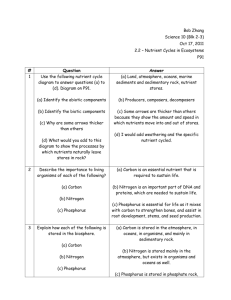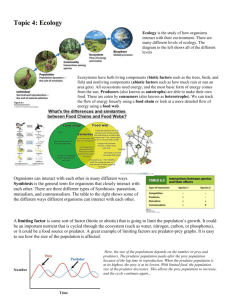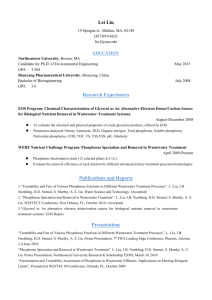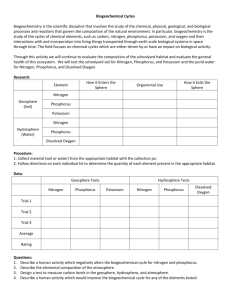Contents
advertisement
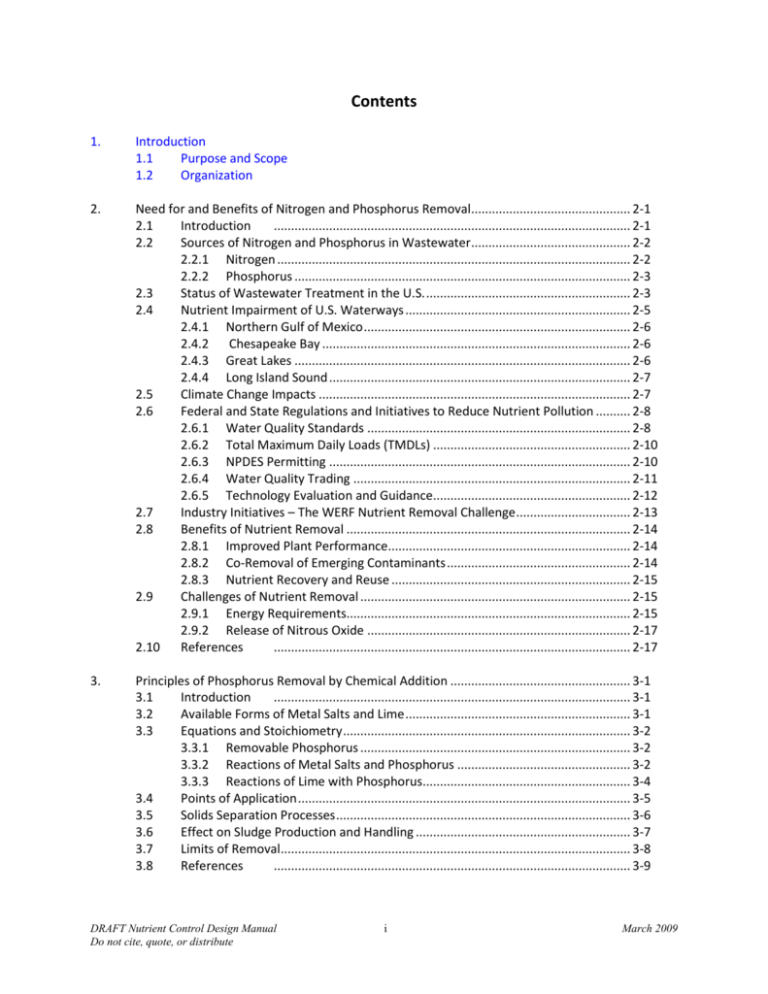
Contents 1. Introduction 1.1 Purpose and Scope 1.2 Organization 2. Need for and Benefits of Nitrogen and Phosphorus Removal.............................................. 2-1 2.1 Introduction ....................................................................................................... 2-1 2.2 Sources of Nitrogen and Phosphorus in Wastewater .............................................. 2-2 2.2.1 Nitrogen ...................................................................................................... 2-2 2.2.2 Phosphorus ................................................................................................. 2-3 2.3 Status of Wastewater Treatment in the U.S. ........................................................... 2-3 2.4 Nutrient Impairment of U.S. Waterways ................................................................. 2-5 2.4.1 Northern Gulf of Mexico ............................................................................. 2-6 2.4.2 Chesapeake Bay ......................................................................................... 2-6 2.4.3 Great Lakes ................................................................................................. 2-6 2.4.4 Long Island Sound ....................................................................................... 2-7 2.5 Climate Change Impacts .......................................................................................... 2-7 2.6 Federal and State Regulations and Initiatives to Reduce Nutrient Pollution .......... 2-8 2.6.1 Water Quality Standards ............................................................................ 2-8 2.6.2 Total Maximum Daily Loads (TMDLs) ......................................................... 2-10 2.6.3 NPDES Permitting ....................................................................................... 2-10 2.6.4 Water Quality Trading ................................................................................ 2-11 2.6.5 Technology Evaluation and Guidance......................................................... 2-12 2.7 Industry Initiatives – The WERF Nutrient Removal Challenge ................................. 2-13 2.8 Benefits of Nutrient Removal .................................................................................. 2-14 2.8.1 Improved Plant Performance...................................................................... 2-14 2.8.2 Co-Removal of Emerging Contaminants ..................................................... 2-14 2.8.3 Nutrient Recovery and Reuse ..................................................................... 2-15 2.9 Challenges of Nutrient Removal .............................................................................. 2-15 2.9.1 Energy Requirements.................................................................................. 2-15 2.9.2 Release of Nitrous Oxide ............................................................................ 2-17 2.10 References ....................................................................................................... 2-17 3. Principles of Phosphorus Removal by Chemical Addition .................................................... 3-1 3.1 Introduction ....................................................................................................... 3-1 3.2 Available Forms of Metal Salts and Lime ................................................................. 3-1 3.3 Equations and Stoichiometry ................................................................................... 3-2 3.3.1 Removable Phosphorus .............................................................................. 3-2 3.3.2 Reactions of Metal Salts and Phosphorus .................................................. 3-2 3.3.3 Reactions of Lime with Phosphorus............................................................ 3-4 3.4 Points of Application ................................................................................................ 3-5 3.5 Solids Separation Processes ..................................................................................... 3-6 3.6 Effect on Sludge Production and Handling .............................................................. 3-7 3.7 Limits of Removal..................................................................................................... 3-8 3.8 References ....................................................................................................... 3-9 DRAFT Nutrient Control Design Manual Do not cite, quote, or distribute i March 2009 4. Principles of Biological Nitrogen Removal ............................................................................ 4-1 4.1 Introduction ....................................................................................................... 4-1 4.2 Nitrogen Removal by Biomass Synthesis ................................................................. 4-2 4.3 Microbiology of Nitrification.................................................................................... 4-3 4.4 Reactions and Stoichiometry of Nitrification........................................................... 4-5 4.5 Nitrification Kinetics................................................................................................. 4-6 4.6 Inhibitory Effects of Environmental Conditions on Nitrification ............................. 4-16 4.7 Denitrification Fundamentals .................................................................................. 4-19 4.8 Microbiology of Denitrification ................................................................................ 4-19 4.9 Metabolism and Stoichiometry of Heterotrophic Denitrification ........................... 4-20 4.10 Biological Denitrification Kinetics with Influent Wastewater .................................. 4-21 4.11 Denitrification Carbon Sources and Relative Consumption Ratios.......................... 4-23 4.12 Denitrification Kinetics of Exogenous Carbon Sources ............................................ 4-26 4.13 Specific Denitrification Rates ................................................................................... 4-30 4.14 Simultaneous Nitrification-Denitrification............................................................... 4-32 4.15 Metabolism and Stoichiometry and Kinetics of ANAMMOX® ................................. 4-33 4.16 Impacts on Sludge Production and Handling ........................................................... 4-33 4.17 References ....................................................................................................... 4-34 5. Principles of Biological Phosphorus Removal ....................................................................... 5-1 5.1 Overview of the Biological Phosphorus Removal Process ....................................... 5-1 5.2 Substrate Requirements .......................................................................................... 5-3 5.3 Sources of Volatile Fatty Acids ................................................................................. 5-5 5.3.1 Fermentation in the Collection System ...................................................... 5-6 5.3.2 Anaerobic Fermentation of Primary or Return Activated Sludge ............... 5-7 5.3.3 Commercial Sources ................................................................................... 5-9 5.4 Environmental Conditions ....................................................................................... 5-9 5.5 Kinetics ....................................................................................................... 5-12 5.6 Important Design and Operational Considerations ................................................. 5-13 5.6.1 Avoiding Secondary Release of Phosphorus ............................................... 5-13 5.6.2 Avoiding Backmixing ................................................................................... 5-15 5.6.3 Flow and Load Balancing ............................................................................ 5-15 5.7 Impacts on Sludge Processing and Handling ........................................................... 5-15 5.8 References ....................................................................................................... 5-16 6. Overview of Nitrogen and Phosphorus Removal Technologies ........................................... 6-1 6. 1 Introduction ....................................................................................................... 6-1 6.2 Nitrogen Removal Technologies .............................................................................. 6-2 6.2.1 Nitrogen Removal in Single Process Unit.................................................... 6-4 6.2.1.1 Modified Ludzck Ettinger (MLE) Process ....................................... 6-4 6.2.1.2 4-Stage Bardenpho ........................................................................ 6-4 6.2.1.3 Sequencing Batch Reactor (SBR).................................................... 6-5 6.2.1.4 Oxidation Ditch with Anoxic Zone ................................................. 6-6 6.2.1.5 Step Feed Biological Nitrogen Removal (BNR) .............................. 6-7 6.2.1.6 The Schreiber Process .................................................................... 6-8 6.2.1.7 Simultaneous Nitrification Denitrification (SNdN) ........................ 6-8 6.2.1.8 Integrated Fixed Film Activated Sludge (IFAS) ............................... 6-9 6.2.1.9 Moving Bed Biofilm Reactor (MBBR) ............................................. 6-10 DRAFT Nutrient Control Design Manual Do not cite, quote, or distribute ii March 2009 6.2.1.10 Membrane Bioreactor (MBR) ..................................................... 6-11 Separate Stage Processes - Nitrification ..................................................... 6-13 6.2.2.1 Suspended Growth Nitrification .................................................... 6-13 6.2.2.2 Attached Growth Nitrification ....................................................... 6-13 6.2.3 Separate Stage Processes - Denitrification ................................................. 6-14 6.2.3.1 Denitrification Filters ..................................................................... 6-14 6.2.3.2 Supplemental Carbon .................................................................... 6-16 6.2.4 Side Stream Treatment Processes .............................................................. 6-16 Phosphorus Removal Technologies ......................................................................... 6-18 6.3.1 Phosphorus Removal by Chemical Addition ............................................... 6-18 6.3.2 Biological Phosphorus Removal .................................................................. 6-21 6.3.2.1 Pho-redox (A/O) ............................................................................. 6-21 6.3.2.2 Oxidation Ditch with Anaerobic Zone ............................................ 6-22 6.3.2.3 Sludge Fermentation ..................................................................... 6-23 Combined Nitrogen and Phosphorus Removal Technologies ................................. 6-24 6.4.1 Biological ..................................................................................................... 6-24 6.4.1.1 3 Stage Pho-redox (A2/0)............................................................... 6-24 6.4.1.2 5-Stage Bardenpho ........................................................................ 6-25 6.4.1.3 University of Capetown (UCT), Modified UCT, and ...................... Virginia Initiative Project (VIP) ....................................................... 6-26 6.4.1.4 Westbank ....................................................................................... 6-27 6.4.1.5 Oxidation Ditch .............................................................................. 6-28 6.4.1.6 Sequencing Batch Reactor ............................................................. 6-29 6.4.1.7 Orange Water and Sewer Authority (OWASA) .............................. 6-29 6.4.2 Hybrid Chemical / Biological and Emerging ................................................ 6-30 6.4.2.1 Blue Plains Process......................................................................... 6-30 6.4.2.2 PhoStrip™....................................................................................... 6-31 6.4.2.3 Biological-Chemical Phosphorus and Nitrogen Removal .............. (BCFS) Process................................................................................ 6-31 Effluent Filtration ..................................................................................................... 6-32 6.5.1 Conventional Down-flow Filters ................................................................. 6-33 6.5.2 Continuous Backwashing Upflow Sand Filters (Dynasand)......................... 6-33 6.5.3 Pulsed Bed Filters........................................................................................ 6-33 6.5.4 Traveling-Bridge Filters ............................................................................... 6-33 6.5.5 Fuzzy Filters................................................................................................. 6-34 6.5.6 Discfilters .................................................................................................... 6-34 6.5.7 Membranes ................................................................................................. 6-34 6.5.8 Blue PROTM Process ................................................................................... 6-34 Summary of Attainable Effluent Limits .................................................................... 6-35 Advantages and Disadvantages of Technology Types ............................................. 6-40 Factors in Simultaneously Achieving Low Nitrogen and Phosphorus ..................... Effluent Concentrations ........................................................................................... 6-44 Summary of Case Studies......................................................................................... 6-45 References ....................................................................................................... 6-46 6.2.2 6.3 6.4 6.5 6.6 6.7 6.8 6.9 6.10 7. Establishing Design Objectives.............................................................................................. 7-1 7.1 Introduction ....................................................................................................... 7-1 7.2 Characterizing Existing Treatment ........................................................................... 7-2 DRAFT Nutrient Control Design Manual Do not cite, quote, or distribute iii March 2009 7.3 7.4 7.5 7.6 7.7 7.8 7.9 7.10 7.11 Design Flow Rates .................................................................................................... 7-3 7.3.1 Characterizing Existing Flow ....................................................................... 7-3 7.3.2 Projecting Future Conditions ...................................................................... 7-5 Wastewater characteristics ..................................................................................... 7-6 Target Effluent Concentrations for Total Nitrogen and Total Phosphorus.............. 7-7 Goals for Reliability, Sustainability, and Process Flexibility ..................................... 7-11 Sludge Treatment Options ....................................................................................... 7-12 Site Constraints ....................................................................................................... 7-12 Selecting an Overall Process Design Factor ............................................................. 7-13 Design Examples ...................................................................................................... 7-14 References ....................................................................................................... 7-14 8. Selecting Candidate Treatment Processes for Plant Upgrades..................................................... 8-1 8.1 Introduction....................................................................................................... 8-1 8.2 Technology Selection Factors ............................................................................ 8-1 8.2.1 Footprint ........................................................................................ 8-1 8.2.2 Hydraulic Considerations ............................................................... 8-2 8.2.3 Sources of Biodegradable Carbon ................................................. 8-3 8.2.4 Chemical needs .............................................................................. 8-3 8.2.5 Available Sludge Treatment and Options ...................................... 8-4 8.2.6 Energy Considerations ................................................................... 8-4 8.2.7 Staffing and Training Requirements .............................................. 8-5 8.3 Overview of Recommended Approach ............................................................. 8-5 8.4 Considerations for Sidestream Treatment ........................................................ 8-6 8.5 Selecting Alternative Carbon Sources ............................................................... 8-8 8.6 Selecting Media for Integrated Fixed-Film Activated Sludge (IFAS) Systems.... 8-9 8.7 Recommended Use of Advanced Tools............................................................. 8-10 8.8 Patent issues...................................................................................................... 8-11 8.9 References ....................................................................................................... 8-12 9. Design Approach for Phosphorus Removal by Chemical Addition ....................................... 9-1 9.1 Introduction ....................................................................................................... 9-1 9.2 Selecting a Chemical Precipitant.............................................................................. 9-1 9.2.1 Advantages and Disadvantages of Metal Salts ........................................... 9-1 9.2.2 Advantages and Disadvantages of Lime ..................................................... 9-3 9.2.3 Costs ....................................................................................................... 9-3 9.3 Selecting Point(s) of Application .............................................................................. 9-4 9.4 Determining the Chemical Dose .............................................................................. 9-6 9.5 Designing a Chemical Feed System ......................................................................... 9-9 9.5.1 Liquid feed systems .................................................................................... 9-9 9.5.1.1 Storage tanks ................................................................................. 9-9 9.5.1.2 Feed Methods ................................................................................ 9-9 9.5.2 Dry Feed Systems ........................................................................................ 9-12 9.5.2.1 Storage ........................................................................................... 9-12 9.5.2.2 Feed Methods ................................................................................ 9-13 9.5.2.3 Slaking (lime).................................................................................. 9-15 9.6 Designing for Rapid Mix and Flocculation ............................................................... 9-16 9.6.1 Types of Mixers ........................................................................................... 9-16 DRAFT Nutrient Control Design Manual Do not cite, quote, or distribute iv March 2009 9.6.2 9.7 9.8 9.9 9.10 10. Design Factors ............................................................................................. 9-18 9.6.2.1 Velocity Gradient ........................................................................... 9-18 9.6.2.2 Power Requirements ..................................................................... 9-18 9.6.2.3 Hydraulic Retention Time .............................................................. 9-20 9.6.2.4 Vessel Geometry ............................................................................ 9-21 9.6.3 Summary of Typical Design Parameters ..................................................... 9-21 Solids Separation Processes ..................................................................................... 9-22 9.7.1 Primary and Secondary Clarification........................................................... 9-23 9.7.2 Tertiary Processes ....................................................................................... 9-23 Operational Factors ................................................................................................ 9-24 9.8.1 Dose Control ............................................................................................... 9-24 9.8.2 Make-up Water ........................................................................................... 9-24 9.8.3 Sludge Production and Handling ................................................................ 9-24 9.8.4 pH Adjustment ............................................................................................ 9-24 9.8.5 Effect on Biosolids Applications .................................................................. 9-25 Design Examples ...................................................................................................... 9-25 References ....................................................................................................... 9-26 Design Approach for Biological Nutrient Removal ............................................................... 10-1 10.1 Introduction ....................................................................................................... 10-1 10.2 Overview of Recommended Approach .................................................................... 10-3 10.3 Establishing Modeling Objectives and Requirements ............................................. 10-3 10.3.1 Intended Model Use ................................................................................... 10-5 10.3.2 Goals for Model Accuracy ........................................................................... 10-5 10.3.3 Dynamic vs. Steady State Simulation.......................................................... 10-5 10.4 Selecting a Process Simulation Model ..................................................................... 10-6 10.5 Data Collection ....................................................................................................... 10-9 10.5.1 Process Configuration ................................................................................. 10-10 10.5.2 Operating Conditions .................................................................................. 10-13 10.5.3 Influent Loading and Wastewater Characteristics...................................... 10-13 10.5.4 Data Verification ......................................................................................... 10-16 10.6 Characterization of Organic Material ...................................................................... 10-21 10.6.1 Relationship of Organic Material and Suspended Solids in Wastewater ... 10-25 10.6.2 Methods for Determining COD Fractions ................................................... 10-26 10.6.3 Data Checks................................................................................................. 10-29 10.7 Characterization of Nutrient Fractions .................................................................... 10-30 10.7.1 Nitrogen ...................................................................................................... 10-30 10.7.2 Phosphorus ................................................................................................. 10-33 10.8 Kinetic and Stoichiometric Parameters ................................................................... 10-36 10.9 Model Calibration .................................................................................................... 10-37 10.10 Model Validation ..................................................................................................... 10-41 10.11 Simulation of Design Alternatives for Nutrient Removal ........................................ 10-42 10.12 Additional Procedures for Design ............................................................................ 10-43 10.12.2 Denitrification Filters .................................................................................. 10-44 10.13 Design Checks for Biological Nitrogen and Phosphorus Removal ........................... 10-44 10.14 Design Examples ...................................................................................................... 10-48 10.15 References ....................................................................................................... 10-48 DRAFT Nutrient Control Design Manual Do not cite, quote, or distribute v March 2009 11. Design Approach for Effluent Filtration ....................................................................................... 11-1 11.1 Introduction ....................................................................................................... 11-1 11.2 Selection of Filtration Technology ........................................................................... 11-2 11.3 Granular Media Filters ............................................................................................. 11-3 11.3.1 Influent Water Quality ................................................................................ 11-4 11.3.2 Media Specifications ................................................................................... 11-5 11.3.3 Filter Loading Rate ...................................................................................... 11-6 11.3.4 Filtration Rate ............................................................................................. 11-6 11.3.5 Headloss ...................................................................................................... 11-6 11.3.6 Flow Control................................................................................................ 11-11 11.4 Compressible Media Filters (CMF) ........................................................................... 11-12 11.5 Cloth Media Filters ................................................................................................... 11-13 11.6 Low-Pressure Membranes ....................................................................................... 11-14 11.6.1 Membrane Material.................................................................................... 11-15 11.6.2 Membrane Configuration ........................................................................... 11-15 11.6.3 Process Considerations ............................................................................... 11-16 11.6.4 Pressure Drop ............................................................................................. 11-17 11.6.5 Flux Determination ..................................................................................... 11-18 11.6.6 Performance Data ....................................................................................... 11-19 11.7 Emerging Filters for Phosphorus Removal to Low Levels ........................................ 11-19 11.7.1 Two-Stage Filtration.................................................................................... 11-19 11.7.2 Iron Oxide Coated Media ............................................................................ 11-20 11.8 Design Examples ...................................................................................................... 11-22 11.9 References ....................................................................................................... 11-22 12. Operation and Optimization to Enhance Nutrient Removal........................................................ 12-1 12.1 Introduction ....................................................................................................... 12-1 12.2 Analysis of Existing Operations ................................................................................ 12-1 12.2.1 Data Analysis ............................................................................................... 12-2 12.2.2 Use of Process Simulation Models.............................................................. 12-5 12.3 Incorporating SCADA and instrumentation ............................................................. 12-6 12.4 Common Operational Changes ................................................................................ 12-6 12.4.1 Adjust SRT ................................................................................................... 12-6 12.4.2 Adjust Aeration Rates ................................................................................. 12-7 12.4.3 Add Baffles to Create High Food to Microorganism (F/M) Conditions....... 12-7 12.4.4 Change Aeration Settings in Plug Flow Basins ............................................ 12-7 12.4.5 Minimize Impact of Recycle Streams .......................................................... 12-8 12.4.6 Reconfigure Flow through Existing Units .................................................... 12-8 12.4.7 Increase VFA for Biological Phosphorus Removal ...................................... 12-9 12.5 References ....................................................................................................... 12-9 13. Instrumentation and Controls 13.1 Introduction ....................................................................................................... 13-1 13.2 Factors in Selecting Instrumentation ....................................................................... 13-1 13.3 Basic Online Instrumentation .................................................................................. 13-2 13.3.1 Flow ....................................................................................................... 13-3 13.3.2 TSS ....................................................................................................... 13-4 13.3.3 Sludge Blanket Depth.................................................................................. 13-5 DRAFT Nutrient Control Design Manual Do not cite, quote, or distribute vi March 2009 13.4 13.5 13.6 13.7 13.8 13.9 14. 13.3.4 Dissolved Oxygen ........................................................................................ 13-5 13.3.5 pH ....................................................................................................... 13-5 13.3.6 ORP ....................................................................................................... 13-6 Instrumentation for Nutrient Control ...................................................................... 13-6 13.4.1 Ammonia..................................................................................................... 13-7 13.4.2 Nitrate and Nitrite....................................................................................... 13-7 13.4.3 Phosphate and Total Phosphorus ............................................................... 13-8 13.4.5 Turbidity ...................................................................................................... 13-8 13.4.6 Total Organic Carbon .................................................................................. 13-8 13.4.7 NADH (active biomass) ............................................................................... 13-9 Types of Control ....................................................................................................... 13-9 13.5.1 Feed-forward .............................................................................................. 13-9 13.5.2 Feedback ..................................................................................................... 13-10 13.5.3 Feed-forward and feedback........................................................................ 13-10 13.5.4 Cascade ....................................................................................................... 13-10 Automated Control and Optimization for Basic Parameters ................................... 13-11 13.6.1 Dissolved Oxygen ........................................................................................ 13-11 13.6.2 Solids Retention Time ................................................................................. 13-11 13.6.3 ORP ....................................................................................................... 13-12 Advanced Automated Control for Nutrient Removal .............................................. 13-12 13.7.1 Nitrogen (various forms)............................................................................. 13-12 13.7.2 Orthophosphate ......................................................................................... 13-13 13.7.3 Respirometry .............................................................................................. 13-13 Control Equipment – SCADA .................................................................................... 13-13 References ....................................................................................................... 13-14 Sustainable Nutrient Recovery and Reuse............................................................................ 14-1 14.1 Introduction ....................................................................................................... 14-1 14.2 Separating and Treating Waste On-Site................................................................... 14-1 14.3 Using Wastewater Treatment By-Products ............................................................. 14-2 14.3.1 Durham (OR) Advanced Wastewater Treatment Facility ........................... 14-3 14.3.2 East Bay Municipal Utility District (CA) ....................................................... 14-3 14.3.3 Stamford (CT) Water Pollution Control Agency .......................................... 14-4 14.4 References ....................................................................................................... 14-4 DRAFT Nutrient Control Design Manual Do not cite, quote, or distribute vii March 2009 Appendices Appendix M. Recommendations for Methanol Safety Appendix N. Organic Compounds and Inhibitory Concentrations to Nitrification Appendix Y. Mathematical Models for Wastewater Treatment Appendix Z. Case Studies DRAFT Nutrient Control Design Manual Do not cite, quote, or distribute viii March 2009



